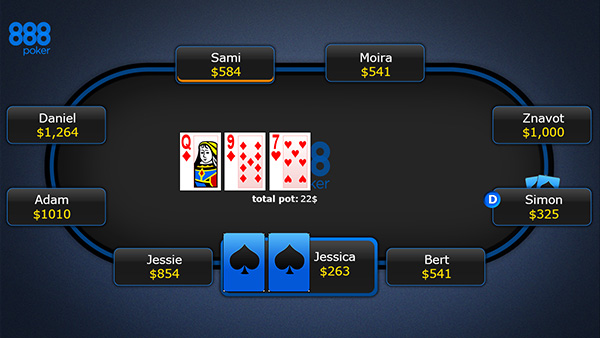Bluff More and Win Big

When most people think of bluffing, they think of an illegal game of poker in a smoky underground casino. Two players battle it out in a huge heads-up pot. A grizzled looking gangster with dark glasses has invested everything on a massive bluff. Initially, it had started with all the money going in, but now he is gambling with his car keys, a yacht, and eventually one of his private villas in the South of France.
Overwhelmed, his opponent folds, realising that he can no longer afford the risk. Our gangster takes a celebratory puff on his Cuban cigar before tabling a bluff with a wry smile.
“Better luck next time, kid”.
The thing that not all people realise is that this is a hugely unrealistic portrayal of bluffing in the game of poker. If we ignore for a minute the fact that it's against the rules to bluff with currency which was not already on the table, the above scenario often results in inaccurate ideas about how bluffing works.
Myth 1 – Bluffing requires huge risks and big bets
While big all-in bluffs have their place in many poker variants, these will typically represent only a small amount of the overall bluffing that takes place. Most of the bluffs we make should be small bluffs in situations where we think our opponents are not interested in the pot.
But how do we know whether our opponent is interested? Usually, his actions will reveal this. We are essentially looking for any signs of weakness. Imagine the following scenario. We call from the BB vs a BTN open-raise. We check the flop and our opponent decides to check back on the following flop texture.

What do you think about our opponents decision to check back on this board? Is there something we can learn about the type of hand he holds? In the majority of cases, it doesn't make sense for him to slow-play a strong hand here because there are so many available draws that we could have. By the time he checks back, he is unlikely to have any set, 2pair or a Queen. Our opponent is “capped” in this situation, meaning that he rarely holds anything stronger than a pair of Jacks, since he would almost always bet the flop.
This should indicate that a bluff on the turn will likely yield a positive result, especially if we also follow up with a river bet. We might not always get our opponent to fold something like JJ by the river, but he should have enough weaker hands that we make real money in the long run.
Myth 2 – A failed bluff is an unprofitable bluff
Have you ever felt frustrated when an opponent snap-calls your bluff with bottom pair when he clearly should be folding? You are likely not the only one. Often, it makes us feel as if we made a mistake and that bluffing was a terrible idea.
The interesting thing about bluffs is that they don't necessarily need to work every time in order for them to be profitable. There is a very simple formula we can use to calculate how often a poker bluff needs to work in order for it to make us money in the long run.
Percentage of Total Pot Invested (including our bet) = Percentage of Time Bluff Needs to Work
See if you can calculate how often our bluff needs to work in the following situation. We are on the river with 50bb in the pot. We make a bluff of 25bb. How often does our bluff need to work? Take a moment to think about this before reviewing the calculation below.
Firstly what is the total pot?
There is 50bb already in the middle, plus hero's 25bb bet. That's a total pot of 75bb.
How much is hero investing?
His bluff is 25bb, this is the amount he is investing.
So what percentage of the total pot is this?
25/75 = 33%
Our bluff needs to work only 33% of the time. This can be pretty counter-intuitive. Can you imagine a situation where our opponent calls 65% of the time when we bluff the river? Often our brain would tell us to stop bluffing because our bluff actually fails the majority of the time! Yet since there is already money in the middle, the fact that our bluff works 35% of the time means that we are slowly generating profit and should continue to bluff.
Myth 3 – Bluffing is a choice
If you've read the article on value-betting then you will know that betting for value in certain spots is mandatory. Perhaps we have the nuts on the river and our opponent checks to us. Not betting would be a crazy mistake since betting can make us so much money.
Bluffs are no different. There are certain spots in the game where it would be absolutely insane not to bluff. Yet, for some reason players don't think of poker bluffing as mandatory. They think of it as something that they can choose to do when the mood takes them.
So why is it that bluffing is a mandatory part of the game, and not simply an optional choice? Imagine we had an opponent that only bets for value and never as a bluff. How would we play against this player? The game would actually be very simple – if he chose to bet we'd immediately fold unless we had a very strong hand. Assuming he didn't bet, we'd know he usually has nothing and we can make small bluffs to take the pot away from him.
Some of you are possibly sitting there thinking that you already beat the lower limit games and yet you never bluff. So how is this possible? This is essentially a result of playing against bad opponents who don't understand how to exploit our tendencies. However, if we are never bluff we are not using a complete strategy and we can run into difficulties against more competent opponents. So bluffing is very important at all limits for the following two reasons.
- At micro-stakes bluffing is often not needed to win but can significantly improve our win rate when used correctly.
- At higher limits against good opponents, we will be far too readable if we only value-bet and never bluff.
Tips for Getting Started
- Remember that most of our bluffs are small, one or two street affairs.
- Calculate how often bluffs in various situations need to work. (For example if our opponent folds more than about 67% of the time to 3bets, we make instant profit with any two cards).
- Pay attention to a player's line to look for signs of weakness. Missing c-bets on any street often indicates weakness.
- Remember that just because a bluff is called does not mean it was an unprofitable poker bluff in the long-term.
- Don't be discouraged if many of your bluffs fail. The solution is not to cut out bluffing entirely, but simply to find more effective ways and situations to bluff.